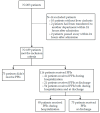The Use of Proton Pump Inhibitors in Patients with Liver Cirrhosis: Real Life Experience
- PMID: 39274368
- PMCID: PMC11396469
- DOI: 10.3390/jcm13175155
The Use of Proton Pump Inhibitors in Patients with Liver Cirrhosis: Real Life Experience
Abstract
(1) Background: Proton pump inhibitors (PPIs) are commonly prescribed for gastric disorders. In patients with liver cirrhosis, PPI use is associated with an increased risk of spontaneous bacterial peritonitis and increased mortality rates; therefore, they should be used with caution. This study aims to evaluate the appropriateness of PPI prescriptions in hospitalized cirrhotic patients against current clinical guidelines to identify patterns of misuse and guide better prescribing practices. (2) Methods: A retrospective study was conducted on liver cirrhosis inpatients in an internal medicine department from January 2022 to May 2023. The primary measure was the proportion of PPI prescriptions aligned with clinical guidelines. Medical files were entirely reviewed by researchers to assess the appropriateness of PPI prescriptions using the current guidelines. Outcomes included the identification of common reasons for PPI prescription and the rate of inappropriate PPI use among the study population. (3) Results: The study included 189 cirrhotic patients, with PPIs prescribed to 95 (50.2%) patients during hospitalization and 75 (39.7%) patients at discharge. Among those, 47.4% of the inpatients and 34.7% at discharge had no valid indication for PPI administration. The most common reason for PPI prescription during hospital stays was gastritis, followed by antiplatelet use in high-risk patients, ulcers, and upper gastrointestinal bleeding. The most common inappropriate indication was portal hypertensive gastropathy (PHG), followed by treatment with corticosteroids and anticoagulants alone. We did not find an association between PPI administration during hospital stays and infections. Only in 4% of cases patients should have received PPIs and did not. (4) Conclusions: There is a concerning overprescription of PPIs in cirrhotic patients, often deviating from established guidelines. It subjects patients to unnecessary risks. There is an urgent need for increased awareness and adherence to clinical guidelines regarding PPI prescriptions in cirrhotic patients.
Keywords: adverse drug reaction; drugs; hepatotoxicity; liver cirrhosis; liver injury; proton pump inhibitors.
Conflict of interest statement
The authors declare no conflicts of interest.
Figures






Similar articles
-
Inappropriate use of proton pump inhibitors in patients with liver cirrhosis: a cross-sectional study.Eur J Gastroenterol Hepatol. 2025 Apr 29. doi: 10.1097/MEG.0000000000002985. Online ahead of print. Eur J Gastroenterol Hepatol. 2025. PMID: 40359285
-
Proton Pump Inhibitors Use and Increased Risk of Spontaneous Bacterial Peritonitis in Cirrhotic Patients: A Retrospective Cohort Analysis.Gastroenterology Res. 2022 Aug;15(4):180-187. doi: 10.14740/gr1545. Epub 2022 Aug 23. Gastroenterology Res. 2022. PMID: 36128183 Free PMC article.
-
Proton pump inhibitors for prophylaxis of nosocomial upper gastrointestinal tract bleeding: effect of standardized guidelines on prescribing practice.Arch Intern Med. 2010 May 10;170(9):779-83. doi: 10.1001/archinternmed.2010.51. Arch Intern Med. 2010. PMID: 20458085 Free PMC article. Clinical Trial.
-
Systematic reviews of the clinical effectiveness and cost-effectiveness of proton pump inhibitors in acute upper gastrointestinal bleeding.Health Technol Assess. 2007 Dec;11(51):iii-iv, 1-164. doi: 10.3310/hta11510. Health Technol Assess. 2007. PMID: 18021578 Review.
-
Proton Pump Inhibitors in Patients with Cirrhosis: Pharmacokinetics, Benefits and Drawbacks.Curr Gastroenterol Rep. 2024 Dec;26(12):323-334. doi: 10.1007/s11894-024-00943-7. Epub 2024 Aug 21. Curr Gastroenterol Rep. 2024. PMID: 39167119 Review.
Cited by
-
Use of Proton Pump Inhibitors Among Patients With Alcohol-Related Cirrhosis-A Danish Nationwide Cohort Study.Liver Int. 2025 Apr;45(4):e70061. doi: 10.1111/liv.70061. Liver Int. 2025. PMID: 40066903 Free PMC article.
References
-
- Baumgartner K., Cooper J., Smith A., St Louis J. Liver Disease: Cirrhosis. FP Essent. 2021;511:36–43. - PubMed
LinkOut - more resources
Full Text Sources

